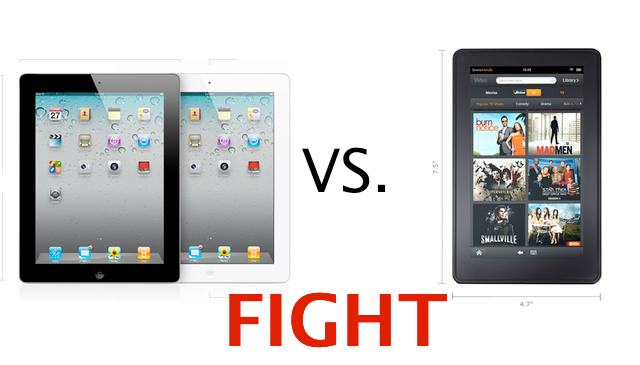Amazon Kindle Fire vs. iPad 2 — An In-Depth Comparison
Amazon has just launched its first real tablet called the Amazon Kindle Fire — a 7-inch device that runs Google’s Android OS, selling for just $200. A torrent of speculation in the months prior to its unveiling suggested the device would be the first to really compete with the iPad, so how does it compare to Apple’s iPad 2?
We take an in-depth look at the specifications for the Amazon Kindle Fire vs. the iPad 2 to see whether Amazon’s new device really has what it takes to worry the iPad.
| Amazon Kindle Fire | Apple iPad 2 | |
| Display: | 7-inch IPS multitouch display (limited to two fingers at once) at 1024 x 600 pixels
169 ppi
|
9.7-inch IPS multitouch display at 1024×768 pixels
132 ppi
|
| Processor: | 800MHz (TBC) dual-core CPU | 1GHz dual-core Apple A5 processor |
| Memory: | 1GB internal storage (expandable to 32GB via microSD)
RAM TBC
|
16GB, 32GB or 64GB internal storage
512MB of RAM
|
| Dimensions & Weight: | 190 x 120 x 11.4mm14.6 ounces | 241.2 x 185.7 x 8.8mm21.3 ounces |
| Battery: | 8 hours reading, 7.5 hours video playback — with Wi-Fi off. | 10 hours of W-Fi web browsing, video or music |
| Camera: | None | 0.7-megapixel rear-facing camera
0.2 megapixel front-facing camera
|
| Operating System: | Android with Amazon’s own UI | iOS |
| Connectivity: | Wi-Fi only | 3G
Bluetooth 2.1 Wi-Fi 802.11b/g/n
|
| Price: | $199 | From $499 |
Based on those specifications, then, Amazon’s first tablet certainly doesn’t look like the “iPad killer” that it was initially rumored to be, but it’ll certainly be a tasty alternative to some.
Leaving aside the device’s smaller form factor — which some people will prefer — and concentrating solely on its internals, the Kindle Fire isn’t quite as powerful as the iPad 2, with a rumored dual-core 800MHz CPU, compared to the iPad’s dual-core 1GHz chip. Despite that, however, first impressions of the Fire from Amazon’s press conference suggest it’s incredibly snappy.
Unlike the iPad, the Kindle Fire’s web browser, Kindle Silk, is a “cloud accelerated mobile browser” that takes the most CPU-intensive parts of loading a website and processes them on Amazon’s servers — allowing pages to load very quickly. The only time you may notice the slower CPU, then, is when you run power-hungry apps like the latest 3D games.
When it comes to storage, the Kindle’s microSD expansion slot allows it to compete with Apple’s mid-range iPad 2, with the option to add up to 32GB of storage. Without that, however, you’re not going to store a great deal of music, movies and apps on the Kindle Fire’s 8GB of built-in storage. But again, Amazon is again focusing on the cloud, and gives all Kindle Fire owners free cloud storage for all Amazon content.
If you want a tablet that takes pictures, the Kindle Fire will be no use to you, with neither a front- or back-facing camera. Also missing is Bluetooth, a microphone and 3G connectivity. Another downside to many of you will be its battery: it’ll only get 8 hours of life from a single charge, and that’s with Wi-Fi turned off.
If you find the iPad is a little too big and heavy for you, then the Amazon Kindle Fire may just be perfect. At just 7.5-inches, the device will comfortably slip into your bag — or even a large pocket — and you won’t even notice it at just 14.6 ounces.
When it comes to the operating system, the Kindle Fire runs Google Android OS, but Amazon has tweaked it so much that you’d hardly notice it. And in my opinion, it’s a fantastic change. Like Apple, Amazon has focused on the user experience with the Kindle Fire, and so the UI has been optimized to work seamlessly with Amazon’s other products, and again, it’s very snappy.
Because the device runs Android, you have instant access to the hundreds of thousands of Android applications already available, and while that might not be as many as the iPad’s App Store, you’ll certainly get by.
And so we move on to the biggest difference between the two tablets: the price. While the Kindle Fire is missing a few features that will be important to some, it is a staggering $300 cheaper, and so for those who aren’t bothered about Bluetooth and cameras and 3D gaming, the Kindle Fire looks like a very nice tablet. Perfect, in fact, for those who want a small device that performs does the basics — and does them very, very well.
Whether the Kindle Fire will really give the iPad a run for its money, however, looks highly unlikely at this point.
What do you think?



